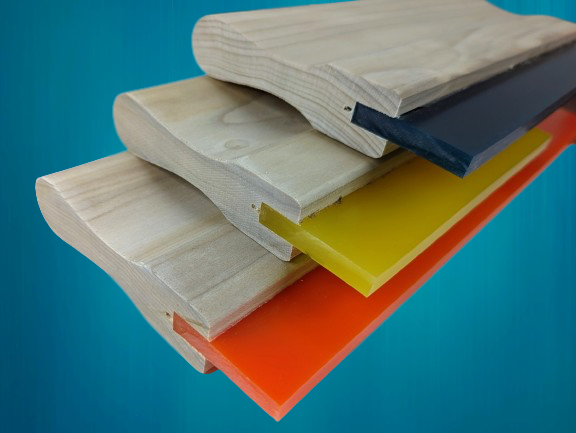
The Ultimate Guide to Choosing the Right Screen Printing Squeegee
Share
Screen printing is an art form that requires precision and attention to detail. From selecting the right ink to choosing the perfect mesh count, every aspect of the process affects the final outcome. However, one of the most crucial elements of screen printing is often overlooked: the squeegee. The squeegee is the tool responsible for transferring ink onto the substrate, and selecting the right one can make all the difference in the quality of the print. With so many options on the market, choosing the right screen printing squeegee can be overwhelming. That's why we've created the ultimate guide to help you navigate the world of squeegees and choose the best one for your needs. Whether you're a beginner or a seasoned pro, this guide will provide you with all the information you need to make an informed decision and achieve flawless prints every time. So let's dive in and discover the world of screen printing squeegees!
Different types of screen printing squeegees
There are several types of screen printing squeegees available on the market. The most common types are made of rubber, polyurethane, or a combination of both. Each type has its own advantages and disadvantages, and the type of squeegee you choose will depend on your specific needs.
Rubber squeegees are the most common type of screen printing squeegee. They are affordable and easy to find, making them an excellent choice for beginners. Rubber squeegees come in different hardness levels, known as durometers, which affects how much pressure is needed to push the ink through the mesh. The most common durometers for rubber squeegees are 60, 70 and 80, with 60 being the softer of the two. Rubber squeegees are suitable for printing on all types of substrates, but they may not be as durable as other types of squeegees.
Polyurethane squeegees are more durable than rubber squeegees and are an excellent choice for printing on high-volume jobs. They come in different hardness levels, ranging from 50 to 90 durometers. Polyurethane squeegees are more expensive than rubber squeegees, but they last longer and provide better ink coverage. They are ideal for printing on substrates such as glass, metal, and plastic.
Composite squeegees are a combination of rubber and polyurethane. They are more durable than rubber squeegees but less expensive than polyurethane squeegees. Composite squeegees come in different durometers and are suitable for printing on a wide range of substrates. They provide excellent ink coverage and are a good choice for high-volume jobs.
Factors to consider when choosing a screen printing squeegee
[caption id="attachment_13206" align="alignnone" width="600"] Wooden squeegee for screen printing[/caption]
Wooden squeegee for screen printing[/caption]
When choosing a screen printing squeegee, there are several factors to consider. These factors will affect the quality of your prints and the longevity of your squeegee.
### Blade durometer and shape
The durometer and shape of the blade are two of the most important factors to consider when choosing a screen printing squeegee. The durometer of the blade affects how much pressure is needed to push the ink through the mesh. The higher the durometer, the more pressure is needed. The shape of the blade can also affect the quality of the print. A square blade is best for printing on flat surfaces, while a rounded blade is better for printing on curved surfaces.
### Handle and grip options
The handle and grip of the squeegee are also important factors to consider. A comfortable handle and grip can make a big difference in how easy it is to use the squeegee. Look for a squeegee with a comfortable grip that won't cause hand fatigue during long printing sessions. Most popular squeegee handles are made from wood. Some squeegees come with ergonomic handles designed to reduce hand fatigue.
### Size and length
The size and length of the squeegee are also important factors to consider. The size of the squeegee will depend on the size of the screen you are using. The length of the squeegee will depend on the size of the print you want to achieve. A longer squeegee is better for larger prints, while a shorter squeegee is better for smaller prints.
### Material compatibility
The material compatibility of the squeegee is also an important factor to consider. Some squeegees are better suited for printing on certain types of substrates. For example, a squeegee with a softer durometer is better for printing on fabrics, while a squeegee with a harder durometer is better for printing on hard surfaces like glass or plastic.
Maintenance and cleaning tips
Proper maintenance and cleaning of your squeegee are essential for prolonging its lifespan. After each use, clean the squeegee with a solvent or cleaning solution to remove any ink residue. Avoid using harsh chemicals that can damage the blade. Store the squeegee in a dry, clean place to prevent rust and other damage.
How to test and evaluate your screen printing squeegee
Once you've chosen a screen printing squeegee, it's essential to test and evaluate it to ensure it's the right fit for your needs. Start by printing a small test run and evaluating the quality of the print. Look for any inconsistencies or imperfections in the print. If the print quality is not up to your standards, you may need to adjust the durometer or shape of the blade. Repeat this process until you achieve the desired results.
Where to Get a Screen Printing Squeegee
There are several top screen printing squeegee brands and products on the market. Victory Screen Factory makes quality wooden squeegees of any length you can possibly need. Order here.
Conclusion and final thoughts
Choosing the right screen printing squeegee is an essential part of achieving high-quality prints. By considering factors like blade durometer and shape, handle and grip options, size and length, and material compatibility, you can select a squeegee that will provide excellent ink coverage and longevity. Don't forget to test and evaluate your squeegee before committing to a large print job, and always practice proper maintenance and cleaning to prolong its lifespan. With the right squeegee and a bit of practice, you can achieve flawless prints every time.
